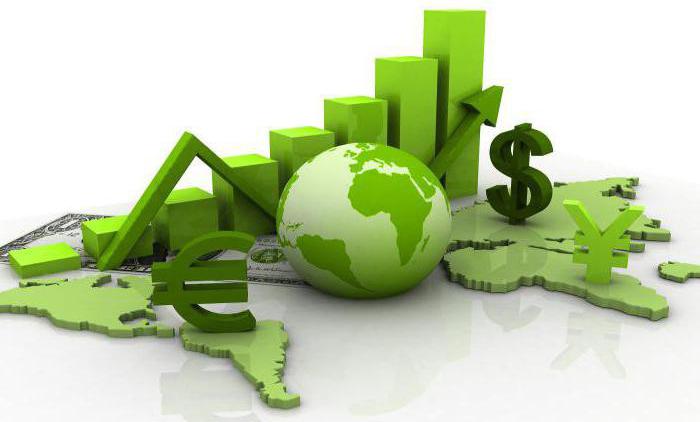Economic indicators characterize the state of the economy, as well as its various objects and processes occurring inside it in three times. By themselves, they represent one of the most popular today and - more importantly - effective tools to determine the state of the economy of a particular company or country.
The composition and structure into which economic indicators are subdivided is one of the most important objects of the study of science, and at the same time they are its substantial element. This system includes a set of systematized characteristics that are interconnected and determine the state of the economy as a whole.
Grouping
Economic indicators in their structure are quite ramified and are divided into groups in accordance with a number of characteristics.
In accordance with the division of the corresponding science into micro- and macroeconomics, generalized macroeconomic indicators are mainly distinguished, which determine the economy as a whole, as well as its various large parts and spheres. There are also microeconomic indicators, which mainly relate to the economy of various enterprises, firms, corporations and all kinds of companies.
What does the structure include?

According to their structure, economic indicators differ by:
- absolute (which are often called quantitative);
- voluminous;
- relative (also called quality).
Absolute and volume indicators are expressed in monetary or physical units, that is, weight, pieces, length, volume, or, for example, a certain currency.
At the same time, the relative economic indicators of the enterprise are the ratio of two indicators having the same or different dimensions.
In the first case, dimensionless characteristics are considered, which indicate mainly the rate of change of a certain economic value or ratio, as well as the proportions of homogeneous economic values, which are subsequently obtained by comparison and measured in percent or fractional terms.
In the second case, we are talking about dimensional indicators, in accordance with which the overall rate of change of a given quantity in time is characterized, as well as the efficiency of using various resources and the sensitivity of the quantity under consideration with respect to a specific factor that causes its change. For example, performance indicator the operation of automobile engines can be measured in accordance with the mass of consumed gasoline per kilometer, while the rate of return on invested capital is the total number of output that falls on each invested ruble.
What are they like?
In the aggregate of relative economic indicators, by which the dynamics of various processes are determined, indicators of growth rate and growth differ. Each of these species is distinguished by its own characteristics.
Growth indicators

Economic indicators of the enterprise, which determine the growth rate, are the ratio of the established amount of the economic product that was manufactured or consumed in a given time period to the amount that was produced or consumed in the previous period. In the overwhelming majority of cases, it is customary to consider a quarterly, monthly, annual period, or simply certain dates.If no changes in the volume of the product occur during the studied time period, this indicates that the growth rate is 1 or 100%, and any deviations already indicate a positive or negative change in this value.
Economic growth indicators determine how the state of the economy is changing, as a result of which they can also be called indicators of the state or change of the economy. Quite often, a group of such relative characteristics, which is used in compiled statistics, is formed by indices. The index itself is the ratio of a certain parameter at the moment to its base value, fixed at a certain time, taken as a basis. In other words, economic growth indicators take into account the index in order to characterize the relative value of a certain parameter in comparison with the baseline (starting), which allows us to understand how this value changed over a specified time period.
Growth rates

Growth indicators of economic efficiency indicate an increase in the number of products sold, produced or consumed over a certain period of time to the amount that is characteristic of the base period. If during this period of time (for example, during the year) no changes in the volume of production are observed, then this indicates that the growth rate is zero, and any deviations already indicate the positive or negative of this characteristic.
By analogy with how high-speed indicators of economic efficiency are measured, in this case the measurement is carried out in percentage terms or in shares. Based on physical analogies, they can be called "indicators of economic acceleration."
Groups

The main economic indicators are divided into a number of different groups depending on their definition, on the location of their numerical values, as well as on what they are used to solve.
The knowledge of calculation-analytical or just calculated indicators is established by performing calculations based on certain mathematical dependencies and economic-mathematical models, and this determination is carried out using certain methods. Settlement and analytical basic economic indicators can often be used as initial in the process of determining planned or forecast parameters, as well as the effectiveness of the implemented socio-economic programs.
Values specific to statistical, reporting or reporting and statistical indicators are based on the financial statements of companies, as well as the collection and processing of various statistical information, observations and sample surveys.
Regulatory technical and economic indicators in most cases are set by the governing bodies, however, they can also represent the norms of resource costs that are allocated for the production of a unit of a certain product, as well as the consumption of various products or the performance of work. Indicators in the form of norms and norms also make it possible to determine accepted, predetermined ratios and proportions, including the rate of accumulation, profit, savings, taxation or remuneration.
Also, technical and economic indicators often intersect with scientific and technical indicators, indicating various achievements of science and technology.
From single, homogeneous or individual indicators that relate to the primary links, aggregate, group, and aggregate indicators are created, according to which a characteristic of various economic objects and processes on a larger scale is provided, covering entire industries, regions or the economy of the country as a whole , and world economy.
In addition, average socio-economic indicators are also used, which represent the average value of an extensive set of values.In this case, one must correctly understand that the average economic indicator does not necessarily have to be the arithmetic average of a group of homogeneous characteristics, as people who are only familiar from afar with economics, as well as modern mathematical and economic statistics, often think.
Weighted average indicators are considered to be more representative, since they give much more clear results.
Where are they used?
The composition, which characterizes the indicators of economic development of companies, is continuously updated and supplemented, and the available methods for its determination are improved. The most widely used economic indicators are found today in planning, forecasting, management and analysis. The success of managing the economy, various economic objects and processes depends quite strongly on the range of indicators used, as well as the degree of completeness that they can characterize managed procedures. In addition, it also depends on how correctly and accurately the definition and analysis of economic indicators was carried out.
Formation system

Analysis of the economic activity of the company is a detailed study of various economic indicators that can characterize various aspects of its work. At the same time, various financial and economic indicators are grouped into a specific system in accordance with certain criteria. Thus, the system that reflects the state of the company’s work is a set of interrelated quantities that allows you to fully characterize the financial position of the company, as well as determine its activities and the results obtained.
Kinds

The economic indicators of the enterprise are divided into two types - these are value and natural. This separation is carried out depending on what specific meters were used in the process of calculating these parameters.
Cost indicators today are the most common form, since they allow you to summarize a variety of economic phenomena. For example, if a company prefers to use various types of materials and raw materials in the course of its work, then in order to determine the generalized amounts of income and expenditure, as well as to understand the balance of these objects of labor, it is necessary to use systemic economic indicators of activity.
Natural indicators can be called primary, while cost indicators are secondary, since the latter can only be calculated on the basis of the first. At the same time, there is a certain number of economic phenomena that can be expressed solely in cost terms, and in particular, this applies to distribution costs, the cost of various products, profits, and many others.
In addition to the natural parameters expressing a specific amount of material values in physical units of measurement, the calculation of economic indicators is also based on conditionally-natural indicators. With their help, you can summarize the volume of various types of products of the same type, which is manufactured by this organization. For example, in the canning industry, all products can simply be expressed in conditional banks, and such a bank, which differs in certain sizes and capacity, will be considered as a conventional unit, and any other similar product, even if of different sizes, is ultimately converted into such a conditional bank. This is how the total volume of goods is expressed in the so-called conditionally-natural indicators.
There is also a division into quantitative and qualitative, depending on which side of the business processes, phenomena and operations will be measured in the particular case under consideration.
Among other things, economic indicators are divided into two types - specific and volume depending on the cast.
Thus, for example, sales, production, profit and cost of goods are volume indicators characterizing the volume of a certain economic phenomenon. Moreover, volume indicators are in this case primary, while specific indicators are secondary. Calculation of specific indicators is carried out on the basis of volumetric and, for example, the prime cost and final cost of production are volumetric characteristics, while the ratio of one indicator to the second, that is, the cost of each ruble of marketable products, will already be called specific indicators.
How is the activity of the enterprise reflected?

The division of economic indicators is carried out in accordance with those areas of the company that are characterized by them. For example, there are such parameters that determine the profitability, profitability or profitability of a particular company. In this case, the main indicator, which will indicate the profitability of the organization, is the ratio of its net profit over a certain time period to the average amount of fixed capital.
The profitability of the organization is defined as the ratio of the profit received from a certain production activity to the revenue from sales, which we managed to extract during the same period.
Profitability ratios in this case are relative profit margins. It is worth noting that there is a whole system of such parameters, and in particular, quite important in this case is return on assets. There are other available indicators, but, as a rule, they represent a variety of options for the ratio of profit to invested capital or production costs.
A fairly important indicator that allows us to characterize the financial condition of the company is the turnover of working capital. If we talk about the most important parameters of turnover, then in this case the duration of one revolution, expressed in days, as well as the total number of revolutions over a certain period, will already be considered.
Speed boost working capital turnover says that on the financial side, the company is strengthening, as well as increasing the efficiency of use of funds and increasing business activity.








